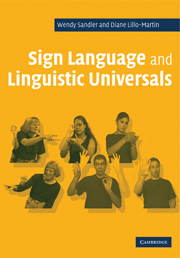Book contents
- Frontmatter
- Contents
- Preface
- Notation conventions
- UNIT I INTRODUCTION
- UNIT II MORPHOLOGY
- 2 Morphology: introduction
- 3 Inflectional morphology
- 4 Derivational morphology
- 5 Classifier constructions
- 6 Entering the lexicon: lexicalization, backformation, and cross-modal borrowing
- 7 Morphology: conclusion
- UNIT III PHONOLOGY
- UNIT IV SYNTAX
- UNIT V MODALITY
- References
- Index
6 - Entering the lexicon: lexicalization, backformation, and cross-modal borrowing
Published online by Cambridge University Press: 05 June 2012
- Frontmatter
- Contents
- Preface
- Notation conventions
- UNIT I INTRODUCTION
- UNIT II MORPHOLOGY
- 2 Morphology: introduction
- 3 Inflectional morphology
- 4 Derivational morphology
- 5 Classifier constructions
- 6 Entering the lexicon: lexicalization, backformation, and cross-modal borrowing
- 7 Morphology: conclusion
- UNIT III PHONOLOGY
- UNIT IV SYNTAX
- UNIT V MODALITY
- References
- Index
Summary
The existence of productive inflectional and derivational morphology in sign languages that have been studied indicates that lexicons of sign languages have much in common with those of spoken languages. Form–meaning correspondences must be listed together with part-of-speech and other syntactic properties. Word-formation rules must also be contained there, be they rules of simple affixation or of templatic association. Productive rules afford a language a way of expanding its lexicon, and this option is exploited in sign languages as it is in their spoken counterparts.
Two other ways in which sign language lexicons may expand are through the lexicalization of classifier constructions and through borrowing. Lexicalization and borrowing are commonly found in spoken languages as well, but in sign language, each has properties unique to the modality. Insofar as classifier constructions are often different from words in semantic, syntactic, phonological, and prosodic structure, their transformation to words is necessarily multifaceted, posing different challenges from those found in spoken language lexicalization. And as sign languages may sometimes reach over into the spoken modality to borrow, the borrowing process also has properties that are different from those that characterize borrowing from one spoken language to another. This chapter focuses on those processes, aiming to distill the general linguistic properties from the modality-rich solution in which they are immersed. Most of the chapter is devoted to the lexicalization of classifiers, presenting examples of monomorphemic signs that are obviously descended from polymorphemic classifier constructions.
- Type
- Chapter
- Information
- Sign Language and Linguistic Universals , pp. 94 - 107Publisher: Cambridge University PressPrint publication year: 2006
- 1
- Cited by



